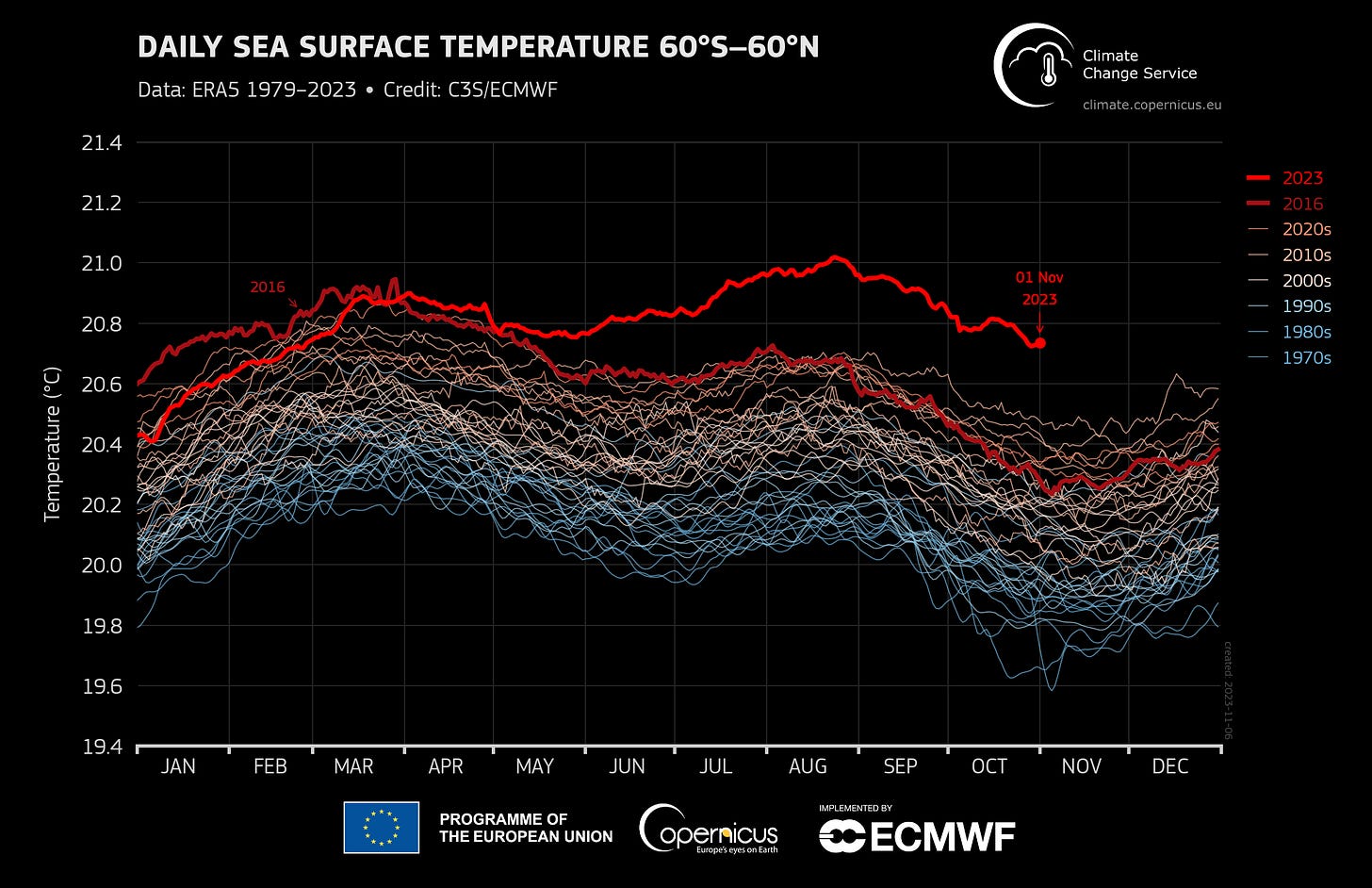🔥 Red October: Charting the hottest month in history
I know you’re tired of the climate news. Every month, we hear another temperature record shattered and another community destroyed by extreme weather events. But October 2023 wasn’t just another statistic in a long string of warnings; it was a month that stood out even in an era increasingly defined by extremes.
As the average global temperature rises, we see a clear sign that our planet is heating rapidly and relentlessly. This isn’t about distant ice caps or far-off futures; it’s about the here and now, and it affects us all. Let’s examine what this record-breaking October means for us.
A sweltering October like no other
Last month, the Earth’s average surface air temperature reached a staggering 15.3 degrees Celsius, surpassing the 1991-2020 average for October by 0.85 degrees and eclipsing the previous October high in 2019 by a significant 0.4 degrees margin.
To put this into context, the warmth we experienced this October was not an isolated event but a symptom of a much larger trend. It stood as the second-highest temperature anomaly for any month, second only to September 2023.
According to the Copernicus Climate Change Service, October 2023 was a whopping 1.7 degrees Celsius warmer than the average October from the pre-industrial period of 1850-1900, a benchmark used by scientists to measure the progress and impact of human-induced warming.

A year of heatwaves
Taking a broader view of the year, the period from January to October 2023 has already set the record for the highest global mean temperature, at 1.43 degrees Celsius above the pre-industrial average. This ten-month period has outstripped the temperatures of 2016, the warmest calendar year on record until now.
Europe, in particular, felt the heat, marking October 2023 as its fourth warmest October on record, with temperatures soaring 1.3 degrees Celsius higher than the recent three-decade average. Such figures reflect a continent — and a planet — that is increasingly warming up.
The World Meteorological Organisation states that climate change affects vital factors that determine health and puts additional pressure on healthcare systems. The Intergovernmental Panel on Climate Change strongly believes that as extreme weather events such as heatwaves, hurricanes, storms, floods, droughts, and wildfires become more common and severe, health-related risks will sharply rise, including injuries, diseases, and deaths.
Yet, by 2030, the United States is on track to extract unprecedented levels of oil and gas, a scenario mirrored by Russia and Saudi Arabia. These nations are poised to collectively produce double the fossil fuels permitted by crucial climate targets, as revealed by the Stockholm Environment Institute.
Oceans are not immune
The planet’s oceans, vast and typically slow to change, also follow a warming trend. The average sea surface temperature for the expansive zone between 60 degrees south and 60 degrees north reached a new high for October at 20.79 degrees Celsius.
Our seas are not just warmer; they are the warmest they have ever been for this time of year. It affects marine ecosystems, weather patterns, and global currents.
The El Niño factor
Developing El Niño conditions have contributed to 2023’s warmth in the tropical Pacific. Though the anomalies remain lower than during the monumental events of 1997 and 2015, the presence of El Niño typically amplifies global temperatures, and it has played its part this year.
Looking ahead
As we move forward, the scientific community and policymakers must grapple with the challenges posed by such clear signals from our climate system. It’s not just about breaking records; it’s about breaking patterns in energy consumption, carbon emissions, and environmental degradation.
Another recent study suggests global warming is accelerating faster than previously thought. The research indicates Earth may surpass the critical 1.5 degrees Celsius warming threshold within this decade and hit 2 degrees Celsius by 2050.
So let me be clear: the climate records are not achievements but milestones of concern, marking the path we are currently on — a path that we can alter with immediate and sustained action. The time for that action is not just now; it was yesterday, last year, last decade. But the next best time is today, and we must seize it.
Finally, a huge thanks for sticking around and for all the support you’ve shown. I know it’s been a while since you’ve heard from me — sorry about that! Life got a bit hectic, but I’m back and ready to roll out some fresh content. I aim to drop a new post once or twice a week from here on out. If you’ve missed any of the past action, no worries–you can catch up right here:
🌫️ Air Thickens: Navigating the Challenges of Pollution in Modern Cities
🌐 Antarctic Ozone Hole Grew Earlier Than Usual in 2023
💧 ChatGPT Uses Half-Litre of Water With Every Prompt Set
🧬 Geneticists Deciphered the Tasmanian Tiger’s RNA Mysteries
😺 The Science Behind Cats’ Tuna Obsession: It’s All About Umami
Elia Kabanov is a science writer covering the past, present and future of technology (@metkere).
Illustration: Elia Kabanov feat. MidJourney. Infographics: Copernicus Climate Change Service/ECMWF.



